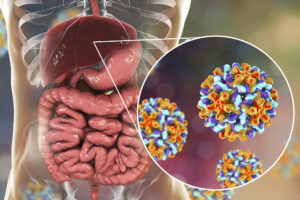 Hepatitis is an inflammation of the liver, most commonly caused by a viral infection. There are five main hepatitis viruses, referred to as types A, B, C, D and E, but it can also be caused due to toxins (notably alcohol, certain medications, some industrial organic solvents and plants), other infections and autoimmune diseases.
Hepatitis is an inflammation of the liver, most commonly caused by a viral infection. There are five main hepatitis viruses, referred to as types A, B, C, D and E, but it can also be caused due to toxins (notably alcohol, certain medications, some industrial organic solvents and plants), other infections and autoimmune diseases.
Hepatitis is acute when it lasts less than six months and chronic when it persists longer. Some types of hepatitis will pass without causing permanent damage to the liver. Other types can persist for many years and cause scarring of the liver (cirrhosis) and, in the most serious cases, loss of liver function (liver failure), which can be fatal. In particular, types B and C lead to chronic disease in hundreds of millions of people and, together, are the most common cause of liver cirrhosis and cancer.
Hepatitis A and E are typically caused by ingestion of contaminated food or water. Hepatitis B, C and D usually occur as a result of parenteral contact with infected body fluids. Common modes of transmission for these viruses include receipt of contaminated blood or blood products, invasive medical procedures using contaminated equipment and for hepatitis B transmission from mother to baby at birth, from family member to child, and also by sexual contact.
Acute infection may occur with limited or no symptoms, or may include symptoms such as jaundice (yellowing of the skin and eyes), dark urine, malaise or extreme fatigue, nausea, vomiting, anorexia and abdominal pain.
Signs and symptoms
Initial features are of nonspecific flu-like symptoms, common to almost all acute viral infections and may include malaise, muscle and joint aches, fever, nausea or vomiting, diarrhea, and headache. More specific symptoms, which can be present in acute hepatitis from any cause, are: profound loss of appetite, aversion to smoking among smokers, dark urine, yellowing of the eyes and skin (i.e., jaundice) and abdominal discomfort. Physical findings are usually minimal, apart from jaundice in a third and tender hepatomegaly (swelling of the liver) in about 10%. Some exhibit lymphadenopathy (enlarged lymph nodes, in 5%) or splenomegaly (enlargement of the spleen, in 5%).
Acute viral hepatitis is more likely to be asymptomatic in younger people. Symptomatic individuals may present after convalescent stage of 7 to 10 days, with the total illness lasting 2 to 6 weeks.
A small proportion of people with acute hepatitis progress to acute liver failure, in which the liver is unable to clear harmful substances from the circulation (leading to confusion and coma due to hepatic encephalopathy) and produce blood proteins (leading to peripheral edema and bleeding). This may become life-threatening and occasionally requires a liver transplant.
Chronic hepatitis often leads to nonspecific symptoms such as malaise, tiredness and weakness, and often leads to no symptoms at all. It is commonly identified on blood tests performed either for screening or to evaluate nonspecific symptoms. The occurrence of jaundice indicates advanced liver damage. On physical examination there may be enlargement of the liver.
Extensive damage and scarring of liver (i.e. cirrhosis) leads to weight loss, easy bruising and bleeding tendencies, peripheral edema (swelling of the legs) and accumulation of ascites (fluid in the abdominal cavity). Eventually, cirrhosis may lead to various complications: esophageal varices (enlarged veins in the wall of the esophagus that can cause life-threatening bleeding) hepatic encephalopathy (confusion and coma) and hepatorenal syndrome (kidney dysfunction).
Acne, abnormal menstruation, lung scarring, inflammation of the thyroid gland and kidneys may be present in women with autoimmune hepatitis.
Types
There are five main types of hepatitis that are caused by a virus, A, B, C, D, and E.
The clinical presentation of infectious hepatitis varies with the individual, as well as with the specific causative virus. Some patients may be entirely asymptomatic or only mildly symptomatic at presentation. Others may present with rapid onset of fulminant hepatic failure (FHF). The classic presentation of infectious hepatitis involves 4 phases, as follows:
- Phase 1 (viral replication phase) – Patients are asymptomatic during this phase; laboratory studies demonstrate serologic and enzyme markers of hepatitis
- Phase 2 (prodromal phase) – Patients experience anorexia, nausea, vomiting, alterations in taste, arthralgias, malaise, fatigue, urticaria, and pruritus, and some develop an aversion to cigarette smoke; when seen by a health care provider during this phase, patients are often diagnosed as having gastroenteritis or a viral syndrome
- Phase 3 (icteric phase) – Patients may note dark urine, followed by pale-colored stools; in addition to the predominant gastrointestinal (GI) symptoms and malaise, patients become icteric and may develop right upper quadrant pain with hepatomegaly
- Phase 4 (convalescent phase) – Symptoms and icterus resolve, and liver enzymes return to normal
This is caused by eating infected food or water. The food or water is infected with a virus called HAV (Hepatitis A Virus). Anal-oral contact during sex can also be a cause. HAV infection usually occurs as a mild self-limited disease and confers lifelong immunity to the virus. Nearly everyone who develops Hepatitis A makes a full recovery – it does not lead to chronic disease.
The incubation period of hepatitis A virus (HAV) is 2-7 weeks (average, 28 days). Clinical symptoms then develop, often with a presentation similar to that of gastroenteritis or a viral respiratory infection. The most common signs and symptoms include fatigue, nausea, vomiting, fever, hepatomegaly, jaundice, dark urine, anorexia, and rash.
This is an STD (sexually transmitted disease). It is caused by the virus HBV (Hepatitis B Virus) and is spread by contact with infected blood, semen, and some other body fluids. You get Hepatitis B by:
Unprotected sexual intercourse with an infected person (unprotected sex means without using a condom) Using a syringe that was previously used by an infected person (most commonly happens with drug addicts and people who inject steroids).
Having your skin perforated with unsterilized needles, as might be the case when getting a tattoo, or being accidentally pricked. People who work in health care risk becoming infected by accident in this way. Sharing personal items, such as a toothbrush or razor, with an infected person.
A baby can become infected through his mother’s milk if she is infected.
Being bitten by someone who is infected.
The incubation period for hepatitis B virus (HBV) is 30-180 days (average, approximately 75 days). Patients then enter the prodromal or preicteric phase, characterized by the gradual onset of anorexia, malaise, and fatigue. During this phase, as the liver becomes inflamed, liver enzymes start to elevate, and the patient may experience right upper quadrant pain. About 15% of patients develop an illness resembling serum sickness. These patients may experience fever, arthritis, arthralgias, or an urticarial rash.
As the disease progresses to the icteric phase, the liver becomes tender, and jaundice develops. Patients may note that their urine darkens and that their stools lighten in color. Other symptoms in this stage include nausea, vomiting, and pruritus.
From this point on, the clinical course may be highly variable. Whereas some patients experience fairly rapid improvements in their symptoms, others go on to experience prolonged disease with slow resolution. Still others may have symptoms that periodically improve, only to worsen later (relapsing hepatitis). Finally, there is an unfortunate subset of patients in whom the disease rapidly progresses to FHF; this may occur over days to weeks.
Hepatitis C is usually spread through direct contact with the blood of a person who has the disease. It is caused by the virus HCV (Hepatitis C Virus).
The incubation period for hepatitis C virus (HCV) is 15-150 days, with symptoms developing anywhere from 5-12 weeks after exposure. During acute HCV infection, symptoms may appear similar to those of HBV infection. In up to 80% of cases, however, patients are asymptomatic and do not develop icterus.
The liver can swell and become damaged. In hepatitis C, unlike hepatitis B, liver cancer risk is only increased in people with cirrhosis and only 20% of hep C patients get cirrhosis. Feces is never a route of transmission in hepatitis C.
Only a person who is already infected with Hepatitis B can become infected with Hepatitis D. It is caused by the virus HDV (Hepatitis D Virus). Infection is through contact with infected blood, unprotected sex, and perforation of the skin with infected needles. The liver of a person with Hepatitis D swells.
The incubation period of hepatitis D virus (HDV) is approximately 35 days. Patients simultaneously infected with HBV and HDV often have an acute, self-limited infection. Fewer than 5% of these patients develop chronic HDV infection.
Chronic HBV carriers who become superinfected with HDV tend to have a more severe acute hepatitis; 80% of these patients go on to develop chronic HDV infection. Chronic infection with HBV and HDV may lead to fulminant acute hepatitis and severe chronic active hepatitis with progression to cirrhosis. Over the long term, as many as 70-80% of these patients have evidence of chronic liver disease with cirrhosis, compared with only 15-30% of patients with chronic HBV alone.
A person can become infected by drinking water that contains HEV (Hepatitis E Virus). The liver swells but there is no long-term consequence. Infection is also possible through anal-oral sex.
The incubation period of hepatitis E virus (HEV) is 2-9 weeks (average, 45 days). No reports exist of chronic infection with HEV.
Hepatitis can be caused by:
- Immune cells in the body attacking the liver and causing autoimmune hepatitis
- Infections from viruses (such as hepatitis A, B, or C), bacteria, or parasites
- Liver damage from alcohol, poisonous mushrooms, or other poisons
- Medications, such as an overdose of acetaminophen, which can be deadly
- Liver disease can also be caused by inherited disorders such as cystic fibrosis or hemochromatosis, a condition that involves having too much iron in your body (the excess iron deposits in the liver).
- Other causes include Wilson’s disease.
There are several laboratory tests that may be used in cases of known or suspected hepatitis, including:
- Abdominal ultrasound
- Autoimmune blood markers
- Hepatitis virus serologies
- Liver function tests
- Liver biopsy to check for liver damage
- Paracentesis (if fluid is in your abdomen)
- Detection of immunoglobulin M (IgM) for hepatitis A virus (HAV) is the standard for diagnosing acute infection with HAV.
- Detection of IgM for hepatitis B core antigen (HBcAg) in serum is required to make the diagnosis of acute hepatitis B virus (HBV) infection. Hepatitis B surface antigen (HBsAg) may be present in acute infection or in patients who are chronic carriers. Its presence in patients with symptoms of acute hepatitis strongly suggests acute HBV infection but does not rule out chronic HBV with acute superinfection by another hepatitis virus. The presence of HBsAg in the serum for 6 months or longer indicates chronic infection.
- Hepatitis C virus (HCV) infection can be confirmed with serologic assays to detect antibody to HCV (anti-HCV) or with molecular tests for the presence of viral particles. Third-generation assays for anti-HCV are sensitive and specific and can detect such antibodies within 4-10 weeks of infection. A rapid antibody test strip has now been approved. Qualitative polymerase chain reaction (PCR) assay for presence of viral particles is the most specific test of HCV infection and may be helpful in diagnosing acute HCV infection before antibodies have developed.
- Assays to detect IgM antibody to hepatitis D virus (HDV) do not need to be routinely performed in all patients with suspected hepatitis.
In general, complications of viral hepatitis may include the following:
- Acute or subacute hepatic necrosis
- Chronic active hepatitis
- Chronic hepatitis
- Cirrhosis
- Hepatic failure
- Hepatocellular carcinoma (HCC) in patients with HBV or HCV infection
Ayurveda Perspective & Management of Hepatitis

Excessive bile production or a blockage in the flow of bile usually indicates high pitta, which in turn affects the agni or enzyme activities responsible for absorption, digestion and metabolism.
Aggravation of the Pitta causes the liver diseases such as hepatitis, cirrhosis and fatty liver.
Kaamala is the term mentioned in Ayurveda to describe the wide range of liver diseases including Hepatitis. Kaamala is a disease of the Raktavaha srotas (a system which includes liver, spleen, blood vessels, and reticuloendothelial tissue) and dominant of pitta dosha. Kaamala is caused due to impairment of pitta dosha and rakta dhatu.
Ayurveda describes various types of kaamala (hepatitis or jaundice) based on the stage or depth of the symptoms. They are:
- Shakhasrita – is caused by the aggravation of all the doshas (Vata, Pitta and Kapha), and is a kind of obstructive jaundice.
- Koshta shakhsrita – results from very high pitta derangement and considered as severe jaundice or hepatitis, difficult to cure.
- Kumbha kamala – is a neglected or untreated stage of jaundice or hepatitis. It can become incurable if not attended immediately. It can be compared with Cirrhosis of liver.
- Haleemaka – is an advanced or neglected stage of Paandu roga that occurs when both the vata and pitta are out of balance.
At CHARAKA, we are providing highly effective treatment for various type or Hepatitis including hepatitis B & hepatitis C. Our treatment is useful in controlling the infection & replication of the virus, preventing further damage to liver. Hepatitis B patients show better response than Hepatitis C.
Our treatment involves Shodana chikitsa (detoxification through Panchakarma procedures), Shamana chikitsa (Palliative researched Ayurvedic medicines) and Kayakalpa (rejuvenation).
Diet restrictions, life style modifications and de-addiction are also the essential factors practiced for the best possible results.

